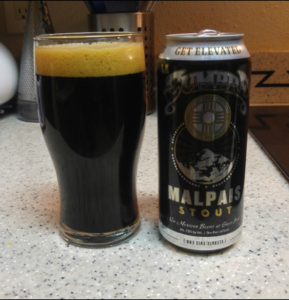 This is my review of La Cumbre (Albuquerque, NM) Malpais Stout.
This is my review of La Cumbre (Albuquerque, NM) Malpais Stout.
The fun part about the English Milk Stout is that it does not contain milk, but it does contain lactose which as we all know is found in milk. Lactose is a disaccharide known for giving people gas because of the angle of the Oxygen bonds between glucose and galactose. That’s the O with the funny z-shaped bond that joins the monosaccharides below.
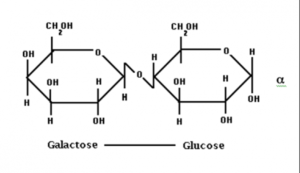
 This bond in similar (but not identical!) to the type of bond found in the same type of polysaccharides found in dietary fiber. Most mammals cannot process fiber on their own, even cows; they process it with the help of bacteria that is passed to the calf from its mother. It’s also why fashion models and beauty pageant contestants eat celery. So as not to lose my audience, here’s Miss Kansas 2014, who I am quite certain eats meat.
This bond in similar (but not identical!) to the type of bond found in the same type of polysaccharides found in dietary fiber. Most mammals cannot process fiber on their own, even cows; they process it with the help of bacteria that is passed to the calf from its mother. It’s also why fashion models and beauty pageant contestants eat celery. So as not to lose my audience, here’s Miss Kansas 2014, who I am quite certain eats meat.
In other words, people have issues with lactose because in a way, humans were never intended to be able to easily process the sugar beyond infancy. The sugar most people associate with beer of course is maltose.

Science AND beer?! What kind of site are we running, anyway?
Looks the same? Not quite. While they have identical chemical formulas, the difference is the angle of the oxygen bonds between the two monosaccharides. What does this subtle to the point where it appears to be a nearly meaningless difference between sugar have to do with beer? It has to do with everything. The yeast that processes these sugars must do so in a different way because of this bond but it can process both easily. The result is a beer that tastes slightly different—sweeter and not as dry. This is the explanation as to why milk stouts taste the way they do, and why not all stouts taste the same and thus were broken up into multiple articles.
Another fun fact about milk stouts: they were initially marketed to lactating women. No wonder your mom likes it.
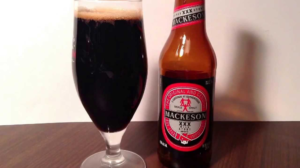
So begins…the circle…of stouts!
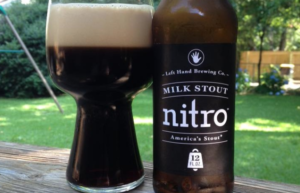 A good example of the English Milk Stout is Mackeson Stout.
A good example of the English Milk Stout is Mackeson Stout.
This one is kind of hard to find in the US, so if you are looking for a good example of the English Milk Stout, check out Left Hand’s Milk Stout. As a bonus, it is also available with the Nitrogen charged widget.
Another type is the English Chocolate Stout. Part 2 of this series I mentioned Young’s Double Chocolate Stout, but an arguably finer example is Samuel Smith’s Organic Chocolate Stout.
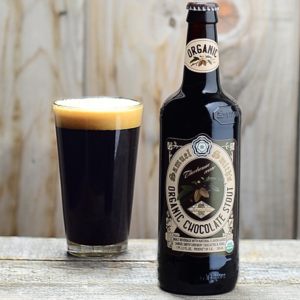
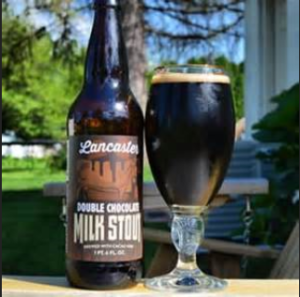 It appears arrogant to the uninitiated yet deliberately proper, and understated–like everything else the English do well. If you can find it, an example from the US might be Lancaster Double Chocolate Stout. I’ve never had this one, but I have heard a lot of good things about it. If I am wrong about it, I will recant on my deathbed.
It appears arrogant to the uninitiated yet deliberately proper, and understated–like everything else the English do well. If you can find it, an example from the US might be Lancaster Double Chocolate Stout. I’ve never had this one, but I have heard a lot of good things about it. If I am wrong about it, I will recant on my deathbed.
As for the stout featured above. I asked everyone what kind of beer I should get on a Friday PM Links thread, and while I got an answer, I had already made my purchase by the time I checked my phone. I picked this because for some reason all the Glibs from the Land of Enchantment seemed to show up all at once one evening. So here is my shout out to the green chili eating weirdos to the east whose most famous resident painted pictures that my former boss has all over her office.

Internet points awarded to whoever actually knows who this is
La Cumbre Malpais Stout has a ridiculous malt complexity and a subtle bite from the hops. It’s ABV is at a healthy 7.5% and there is a slight burn to it. This one is rather dry like an Irish stout, because it is. Its old-world analogue is Guinness Extra Stout. It is a solid effort, and one I would recommend. La Cumbre Malpais Stout 3.5/5

First – just put a couple of Polygamy Porters into the fridge for later.
Oh yes. Big fan.
I get so many comments from the T-shirt.
Haha! I bet! A couple-friend of ours are big fans of this particular porter. The husband has the t-shirt, as well, and he does catch a lot of shit for it depending on where he wears it.
I gave you a suggestive photo of a probably lesbian artist in an article about milk stouts. I thought I had you set up for alt-text.
Everyone’s a critic xD
Why didn’t you supply the alt-text?
Why didn’t you supply the alt text?
That’s the editors job. But here goes: Does Georgia want a stout or Miss Kansas?
Both.
Huh. That’s one of the few pictures you can’t see her unibrow in unless you’re looking for it. She should have worn brimmed hats more often.
Shit. I confused her with that other crap artist feminist like. Oh well, no points for me.
Frida was an Old Mexican, not a New Mexican if I remember correctly.
Salma was miscast then, wasn’t she?
Irrelevant. What’s important is Salma still looks good.
Also thr sugars are switched. It might just be my phone.
Well, shit. Sorry about that. I thought I paid special attention to that because I did not want to fuck it up.
I think the only one that would notice anyway is OMWC. Hes at a Lambeu getting a handy, so no worries!
Should be correct now. 😉 Sorry about that.
Gracias
Nice chemistry lesson, now I know why I can’t stand Milk stouts,
Nice article MS! always something new to try
Lancaster Double Chocolate Stout
They are just across the river from me, I’ll check them out. Maybe I’ll haul a growler over.
They’re great. I think I have some in my fridge.
Good, I can mark that off the list of things to recant on my deathbead.
loved having left hand’s on tap around Boulder.
So I need a Periodic Table and an Art History book when I come here now? Sheesh! jk. I’m a big fan of Stouts but did not care for the Left Hand Nitro Milk Stout I had on tap somewhere. I don’t think I’ve tried a Milk Stout since.
We may be assholes, but damnit, we’re cultured assholes!
I’m generally not a fan of milk stouts, because I don’t like the additional sweetness. When used with a restrained hand however, you get a nice rich mouthfeel from the lactose. A good example is the Arabicadabra from Bell’s.
Oh, I’m not sure I tried that one. I like Bell’s so I’ll give that one a try. I think I’ve actually seen that on tap.
I’ll have to bookmark that one for later, as you can imagine I’ve been drinking a lot of stouts lately.
Internet points awarded to whoever actually knows who this is
Franken’s mom?
I’m not sure I’ve ever had a milk stout. Will try.
Nice job, as always!
They’re delicious.
In days of yore, Mackeson’s was one of the only “classy” beers I could regularly find in a field otherwise populated by domestic swill (the other being McEwans Scotch Ale, which in retrospect, may not have been that classy). Anyway, I went through a lot of Mackeson’s back then. These days, I think I’d find it a bit sweet.
Also, +1 on the Sammy’s Chocolate Stout. Dee-lish.
It’s been a long time for me. I found Mackeson at an AAFES Class 6 in SC about 10 years ago.
Mackeson’s was the first milk stout I had. Pretty good.
Young’s and Samuel Smith make good Chocolate Stouts.
Where do I cash in my internet points?
Right here.
😉
A beer post… all I bought today was booze.
Oh, and if you want a bizarre flavor combination, mix Anise Liqueur with Kahlua. The aftertaste will sit there and change flavor over time.
Even vanilla is a bizarre flavor combination for UCS.
“Still water please, no ice.”
-UCS
(._.)
Aww, don’t feel bad, UCS. You can find a complex depth of flavor in a lot of individual flavors when you’re really looking for it.
dinner at the ucs household
http://imgur.com/vVjHHEn
mix Anise Liqueur with Kahlua
That is the most ambitiously revolting thing ever…. gah!
The aftertaste will sit there and change flavor over time.
Puke will do that.
Recurve or GTFO. (Cute, though.)
Compound bows have a metastable state at a full draw and provide better mechanical advantage. They’re both more comfortable and more powerful (for the same shooter)
Compounds are fine for hunting. For target shooting… if you want more powerful and comfortable, get a gun.
I’m no archer, but I can respect a purist.
Unless there’s no plastic anywhere peachy ain’t no purist.
I had recurve in highschool – aside from a bit of rubber, pretty sure it was all wood and metal.
Oh and where’d you get that rubber hmmm? From all those English rubber trees in 1275 AD?
I hate you revisionists. English longbow or GTFO.
I hate to think how much an actual yew longbow would cost these days.
In the mid 2000s about seven hundred to eight hundred bucks Canadian.
I won’t own a bow other than a recurve. I fired a compound bow once and thought it was weird. I went back to recurves and never looked back.
However, despite my recurve bias, I won’t kick a hot blonde out of bed because she shoots a compound bow.
A sensible man. She can’t bring the bow, though.
Does anyone here know anything about garage door openers?
I’ve got 2 Overhead Door 456’s, I was able to troubleshoot one of them and get it running properly again. Having more issues with the other. If you press the button to activate it, it will start to close for about a half second at most and then return to the fully open position. I thumbed through the owners manual and didn’t see anything that really matched my issue. None of the lights come on or do anything different when operation is attempted, manual use of the door is easy and free of obstructions, photocells appear to be properly aligned. This issue occurs whether the door’s operation is attempted through the button on the wall, or the transmitter.
One possible cause per the manual is a ‘defective internal reversing system’, but I haven’t been able to scrounge up any info on how that system works, how to test for that or fix it.
Any thoughts?
I don’t know much about garage doors specifically. That said, you should have photo eyes looking at each other which will prevent the door from closing if they are blocked. If they are obstructed that may be your problem. Also, if you are wired to the normally open instead of normally closed switch in the reciever of the photo eyes, that could be your problem. To check that, block your photo eye and see if the door operated correctly.
Photocell=photo eye
Thanks for the suggestion. I tried blocking the photo eyes, it caused the door to go in the fully open position, but it still wouldn’t close at all.
It could be possible that either the transmitter or the button on the wall is giving the door an open command all the time. Maybe try taking the batteries out of the transmitter or unworn the switch on the wall amd try each one individually.
Also, inside the box where the motor and transmission are located, there should be geared closed and open limits that tell the controller when the door is fully opened and fully closed. Make sure that the door closed limit isn’t being made prematurely.
unwire, not unworn
“Make sure that the door closed limit isn’t being made prematurely.”
That was the problem with my other door, only in reverse (the door close limit was set too far away, so it thought it was squishing kittens).
I had the same issue with my garage door “sensing eyes.” Turns out that it’s common for the capacitors and other components inside the electronic eyes to wear out over time, especially in cold climates. They are pretty simple circuit boards so you could try to solder in replacements yourself. I found all-new sensor pairs that matched my system on Amazon for $11, so I didn’t bother with trying to salvage the old stuff.
Haven’t had a problem since.
But I wasted a lot of time before that trying to perfect the alignment or figuring out if it was worse when raining or when the sun was in just the wrong position etc. Nope; they were just wearing out.
How did you know it was the photo eyes that were caput?
Mine appear to be functioning, but I think they’re pretty old, and we get a bit of cold here.
I didn’t know for sure, but the opener itself was only 2-3 years old, and the guy who installed it just left the old eyes because the wires were already run and it worked fine with the new opener.
The eyes were probably well over 10 years old. The symptoms sounded right for what I was observing (which at first I could sometimes correct by nudging the eyes slightly until both LEDs lit up, an indication that they see each other), but over time even that was intermittent. I think the beams get weaker and weaker, and the field or width of the beam gets narrower until they just won’t work long enough to complete the closing operation. Opening is never a problem because that’s the default “safe” state of the garage door. Capacitors (especially electrolytic ones) are known to give up the ghost with age, so it seemed reasonable and cheap enough to try.
Incidentally, about a year later I had to replace the original remote controls too. Also cheap, and dead easy to program to the existing opener.
Something I noticed on my doors: On the one door, the eyes are mounted on the rails and not the wall. One of the rails worked loose. When the door closes, the rail wobbles, and the eyes don’t point at each other. The door won’t close. Interesting timing too as this started a couple of days after I signed a contract to have the doors replaced.
Any power surges in your house?
Not too long after I bought my house, one of the openers was fried in a power surge due to a nearby lightening strike. The first time I used the door after the surge, it opened without a problem. It would not close when I used the wall switch or transmitter, but was fine with manual operation. The door would move about an inch, then return to the fully open position. For me, the light stayed on the whole time. I gave up trying to figure out what was wrong, and called a repairman. He figured out the opener’s control board had been fried, replaced it, and the door worked fine afterwards.
A bit of a rant about the quality of new things.
Why does a garage door need a control board? A printed circuit board is a vulnerable component that is not repairable and is totally unnecessary to control a garage door.
All you need to control a garage door motor is couple relays some switches a photo eye, motor overload, and a rf reciever with two sets of contacts.
Even with a PCB, you still have to have most of these components, so I’m not seeing where the PCB controller is saving any costs in the manufacturing process. It’s making a simple system complicated.
I have worked on a bunch of large older overhead doors that have a system like I describe. They work fine and when a component fails, it’s easily replacable. I have worked on newer doors that have had failures in their PCB controllers. There is nothing you can do with them aside from buying a new PCB from the manufacturer or building your own controller. I have built door controllers rather than buying a new board several times.
I agree about your rant.
I think you need some smarts in the overhead opener because of the remotes you have in your car. They have to use a changing signal so that they can’t be hacked by random criminals driving around your neighborhood.
That’s why when you get a replacement remote, you have to push a button way up on the opener itself (while pushing the new opener) so they exchange keys and will be able to communicate with each other and no others.
If you didn’t want a remote, or at least one with some security, a scheme as simple as the one you describe would be fine.
A rfid reciever that can be set to the specific frequency of your remote would suffice. That is what we use on the remote control cranes and skids steers where I work.
It’s too easy for someone standing by (with the right equipment) to catch your frequency when you push your opener and then come back later to break in using that frequency. That’s why just about everybody adopted the revolving code approach in the early 90s.
I’m sure it’s fine for your industrial purposes because I can’t imagine the criminal incentive for someone in the plant surreptitiously nabbing the control frequency of the cranes.
I’ll stick with my revolving code door opener.
You’re probably correct. I can’t imagine anyone in my area being capable of doing what you are talking about, but I guess in different parts of the country, the criminals may be more sophisticated.
I guess, I think that there should be a market for both, and there probably is. Stuff being over engineered to the point of being beyond my capabilities to work on it is my main gripe.
Yeah, no reason to put a microcontroller in a bunch of stuff when simple logic (or none at all) would do the trick. But they do it anyway! I would never get a “smart house” where I can control lights, locks, etc with a smart phone. Too much to go wrong.
When I design low voltage circuits to control high voltage, high energy systems (which are potentially lethal, and also critical to keep operational), I ALWAYS opt for real-time combinational logic chips, preferably CD4000 series cmos running at 15V for the inherently high signal-to-noise ratio.
In one project I am on now, the customer insisted on it all being controlled over CAN bus, which is simply unnecessary for the level of operations we are performing, and for 3 years, it’s been nothing but trouble. The fact that most of the shitty microprocessors run at 3.3 V doesn’t help.
I have the satisfaction of having argued against the decision so hard that when I took meeting minutes, I recorded that I had told them all that I reserved “I told you so” rights for when it came back to bite them.
Still wish they had just listened to me and let me do it right instead of farming it out to a bunch of low voltage dudes & SW writers who have never had to coexist with high voltage systems in military settings. My smug “I told you so” won’t make us any safer at this point.
Jerry Jones may be in some seriously deep shit.
Making a racially insensitive remark on video would normally be problematic, but since Jerry Jones was already in the headlines and the force behind the push to come down on NFL players who refused to stand for the national anthem, I suspect this gets big.
Meanwhile, he’s taking on the commissioner and diving the NFL ownership over Goodell’s contract?
The man has enemies in the NFL now. He’s made himself an enemy of Black Lives Matters. No they have him on video saying racially insensitive shit?
Bad week ahead of Jerry Jones.
I bet any woman who may have felt uncomfortable around him over the last 30 years is calling Gloria Allred to join the dogpile.
Yeah, its an unusual situation. I don’t like the Cowboys, Jones, or Goodell. I think the kneeling protests is a source of misplaced outrage–on both sides. All they’re doing is competing to be the biggest dick in football. It makes me appreciate the college game more.
Because there are no dicks in the NCAA like Urban Meyer, Jim Harbaugh, or the administrators.
Out west, I can easily ignore Harbaugh, Meyer, Spurrier and all the other clowns that take themsleves too seriously.
Jerry’s players love him. He’s an honorary black guy. Sort of like Bill Clinton.
One possible cause per the manual is a ‘defective internal reversing system’, but I haven’t been able to scrounge up any info on how that system works, how to test for that or fix it.
Is it supposed to go back up if it hits something? Could it be getting some sort of an obstruction trigger? Not sure what it might be…
If the motor encounters too much resistance it will stop and backup. Over time the rollers get worn or out of alignment and can cause enough resistance. You might not notice it when moving it by hand . I’ve had this happen several times. The rollers are really wear and tear items.
Sometimes there’s an adjustment for increasing/decreasing the amount of resistance the motor will accept
All good thoughts, I will try taking a look at the rollers and maybe adjusting the chain to see if that helps. The motor setting had been on the highest pressure allowable, and that didn’t solve the issue. To be honest I think it may have a mechanical issue as well, but it used to work despite that.
OT:
Fragile white people (which is all of them) should not be teaching.
And if you disagree that’s proof of how fragile you are.
It’s what’s called “Kafkatrapping”
A beer that if I drink too much will give me a stomachache as well as a hangover?
Fuck you.
Despite my partial lactose intolerance, I’ll help you out and take them off of your hands.
I’ll trade for a good cream ale.
I’m out of them. How about a Backwoods Bastard?
Is that any good?
I like scotch ales (e.g. Founder’s Dirty Bastard), but the bourbon barrel aged beers are typically too much for me.
I think so. There is a bourbon taste to it. Whether or not it’ll be too much for you, I don’t know.
I think this review answers my question.
I’m going to guess barrel aged beer just isn’t for me, the concept sounds amazing, and I can (to a degree) appreciate the complexity of the flavors, but they just don’t do it for me.
That is an interesting review.
Funny the reviewer mentions “Dueling Banjos”. Whenever I see the label or drink the beer, I’m reminded of Popcorn Sutton.
I’m jealous. I can’t get drunk enough anymore to be hungover from drinking beer.
Good review! Thanks!
Insanity to start the night.
Nice.
That’s a good and dangerous beer. Have you tried the cinnamon variant yet? I’m interested in it, but I’m not sure I want to commit to it. Same issue I’m having with the Southern Tier Imperial Cinnamon Roll.
For reference, almost every brewery here in Cleveland does a Christmas ale that’s spiced with cinnamon, nutmeg, clove, and/or ginger, in various amounts. Hoppin’ Frog (a generally solid brewery) has one called Frosted Frog that’s just a flat out cinnamon bomb.
I saw Cinnsanity when I last visiting relatives in Pennsylvania, but I didn’t buy it. My fridge is full and there’s lots of stuff in my cabinet.
I like cinnamon. The Frosted Frog looks good.
Damn, nearly tried one this afternoon. Went with a barrel aged russian imperial stout.